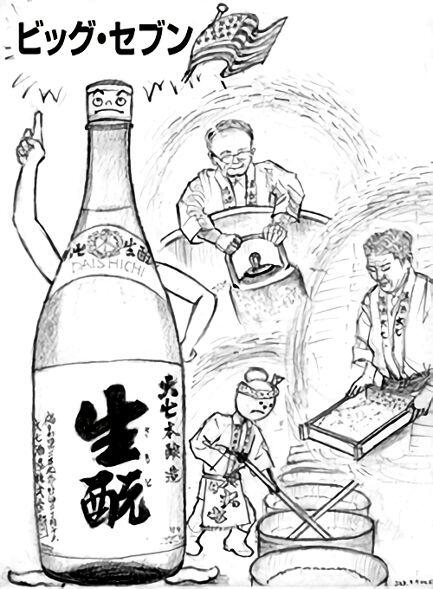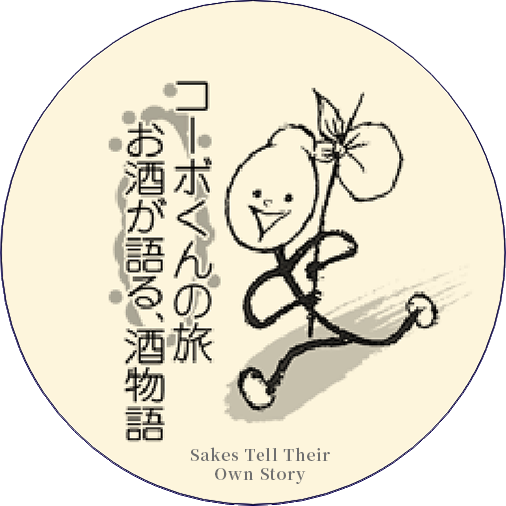| Yeast |
“Today I’ll visit Daishichi’s greatest star, Minowamon. He has raked in many first prizes at various competitions, including two years in a row the Platinum Prize at the Great Jizake Show organized by a specialist organization that licenses sake sommeliers. There’s no match for him!” |
| Minowamon |
“Hello, Yeast. What an enthusiasm!” |
|
 |
| Yeast |
“That’s because I’m really looking forward to this visit. Could you start by telling me more about your name?” |
| Minowamon |
“Minowamon is the name of the castle gate here in Nihonmatsu. As you know, the castle burned down in the disturbances at the beginning of the Meiji period. Only the walls and the gate of the castle are left as symbols of noble courage.” |
| Yeast |
“So it’s a name that reminds us of history and tradition! And when did you first appear?” |
| Minowamon |
“That goes back to 1993. At that time, Mr Tomio Saito, a technical official of the Japanese government, published his theory about flat rice polishing in an academic journal. Based on research, he put the theory forward that the correct way of rice polishing is not the conventional one which has the problem that it makes the rice into round balls, but that the rice should rather be polished in such a way that it becomes flat.” |
| Yeast |
“Daishichi soon took note of that article. Why did the other breweries overlook it?” |
| Minowamon |
“Because we at Daishichi felt this might mean a breakthrough for us. We were in fact facing the following problem. Daishichi aims at a combination of power and stylishness, but in order to bring the complex sake made with the kimoto method to a higher level of sophistication, we had to overcome an extra-large hurdle.” |
| Yeast |
“The key was flat rice polishing! Did it succeed from the start?” |
| Minowamon |
“No, on the contrary, it was a long and troublesome process. The correctness of the theory had been proven, but it seemed impossible to put it into practice in a factory using a large amount of rice. The makers of the rice polishing machines were also pessimistic.” |
| Yeast |
“So the only way was to work out original know-how by a process of trial and error.” |
| Minowamon |
“We tried hard for quite a long time. But finally we succeeded in taking flat rice polishing to such an advanced level that even its original inventor, Mr Saito, was surprised. I was born in 1995 as the very first junmai daiginjo made with the kimoto method produced with rice polished with the super-flat rice polishing technique.” |
| Yeast |
“And the manager of the polishing plant, Mr Yoshio Ogata, received the Award of Contemporary Master Craftsman, the first time this title was awarded for rice polishing!” |
| Minowamon |
“I still feel that as a great honor.” |
| Yeast |
“Me too! By the way, your bottle design, Minowamon, is very popular thanks to its splendor and charm.” |
| Minowamon |
“Thanks. The motif consists of ivy leaves, which fit well to a sake brewery. The ivy on the walls of Daishichi’s brewery bring the summer temperature down by three degrees.” |
| Yeast |
“I see, ivy is a motif that is typical of Daishichi’s top sakes, isn’t it? After bottling, these are all thoroughly matured in our low temperature storage warehouse.” |
| Minowamon |
“Yes. Junmai daiginjo should be a sake that fits to food and it therefore needs a well-balanced umami. It’s wrong to put too much emphasis on just fragrance. In other words, the period of maturation is most important of all.” |
| Yeast |
“That must be what is called ‘sake brewing that can stand the test of time!’ Which dishes are suitable?” |
| Minowamon |
“I received the Platinum Award as sake that fits to salmon roe and crab. But I of course also fit to the Japanese high-class cuisine called kaiseki, or in the case of Western food, to scallops and sauté of white fish, and also to duck. Preferably serve me lightly cooled.” |
| Yeast |
“You seem to be very popular in top restaurants in Europe and America.” |
| Minowamon |
“That’s true. I also had the honor to be the first Japanese sake served at a banquet of the royal family of the Netherlands, in 2010.” |
| Yeast |
“Amazing! Keep doing your best, you have my support!” |
| Minowamon |
“Thanks, and see you again.” |





